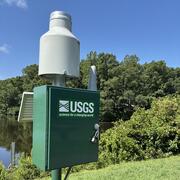Surface Water
Surface Water
From tiny creeks to massive lakes and rivers, surface water is what we often think of when we picture water in the environment. Browse our studies focused on surface waters below.
Filter Total Items: 16
Effects of Abandoned Coal Mine Drainage in the New River Gorge
Many abandoned historic mines surround the New River Gorge. Untreated water draining from these mines has the potential to alter the temperature and water quality of nearby creeks and rivers. Remediation and restoration has been proposed for many of these abandoned mines. However, the cold water seeping out of these mines may also create wetland areas along the flat mine benches which were cut...
Henrico County Hydrologic Monitoring Network
The USGS Virginia and West Virginia Water Science Center has established a comprehensive network of hydrologic monitoring stations throughout Henrico County. Precipitation and water-level data collected from these stations are used to inform floodplain management, reduce the risk of flooding, and inform emergency management. On this page, you can access our data and learn more about the Henrico...
USGS Publications Summarize Water-Quality Trends and Drivers in Urban Streams After 10 Years of Monitoring in Fairfax County, Virginia
Issue: Degraded water quality and ecology in urban streams has been widely documented, but explanations of changing conditions over time are often unavailable. A 15-year collaborative urban stream monitoring effort between the Fairfax County Stormwater Planning Division and the U.S. Geological Survey (USGS) is ongoing and has begun to shed light on this complex issue. In a new USGS report by...
Source Water Monitoring on the Roanoke River in Salem, Virginia
The Roanoke River is the primary source of the City of Salem's drinking water. Threats to water quality in rivers like the Roanoke have increased in recent years, and water authorities as well as residents are concerned about preventing source water contamination. Realtime water quality monitoring is a valuable tool in alerting water authorities such as Salem Water when there are anomalous...
Investigation of Drivers of Harmful Algal Blooms on Lake Anna, Virginia
The U.S. Geological Survey (USGS), in cooperation with the Viriginia Department of Environmental Quality (DEQ) is monitoring harmful algal blooms (HABs) on Lake Anna in Virginia. The hydrology, water-quality, and weather conditions are evaluated both continuously and discretely to analyze the causes, persistence, and decline of HABs in two tributaries and along Lake Anna. Synoptic monitoring of...
Investigation of Drivers of Harmful Algal Blooms on the Shenandoah River, Virginia
The U.S. Geological Survey (USGS), in cooperation with the Viriginia Department of Environmental Quality (DEQ) and collaboration with the Interstate Commission on the Potomac River Basin (ICPRB) is monitoring harmful algal blooms (HABs) on the two forks of the Shenandoah River in Virginia. Continuous and discrete water-quality and hydrology data is conducted to understand the drivers, persistence...
Hydrologic Monitoring and Analysis to Support Water Resource Management in the City of Roanoke
The U.S. Geological Survey, partnering with the City of Roanoke and Virginia Tech, are working to monitor the water volume and quality in streams throughout the City of Roanoke. There are currently six monitoring stations within the city. Water-quality data are collected at five stations through real-time monitors. The overall objective of the study is to quantify the amount of sediment delivered...
Improving Time of Concentration Estimates for Small Rural Watersheds in the Appalachian Plateaus Physiographic Province, West Virginia
Many culverts and other drainage structures in rural West Virginia are located in small streams or valleys draining 100 acres or less. Design of these structures in West Virginia is generally done using discharge estimates made with widely used and well accepted methods. However, these methods require information including flow-segment length and channel geometry that are poorly characterized for...
Climate Change in the Chesapeake Bay Watershed: Effects on Riverine Discharge, Ecosystems, and Water Quality
The 64,000-square mile watershed that drains to the Chesapeake Bay is highly populated and has diverse land use, including forested, agricultural, and urbanized areas. Increased precipitation in the eastern United States over the last 100 years has affected stream flow and thus the loading of pollutants delivered to the bay. Such pollutants as suspended sediment and dissolved phosphorus and...
USGS-VDOT Bridge Scour Pilot Study
Cost effective and safe highway bridge designs are required to ensure the long-term sustainability of Virginia’s road systems. The water flows that, over time, scour streambed sediments from bridge piers inherently affect bridge safety and design costs. To ensure safety, bridge designs must anticipate streambed scour at bridge piers over the lifespan of a bridge. Until recently Federal Highway...
Fairfax County Water Resources Monitoring Network
In recent years, hundreds of millions of dollars have been invested into the implementation of Best Management Practices in Fairfax County, Virginia, with the goal of improving water quality. Research has demonstrated that best management practices are effective at smaller scales, but less information is available to document the effectiveness of these best management practices at the watershed...
Hampton Roads Regional Water Quality Monitoring Program
In 2015, the U.S. Geological Survey partnered with the Hampton Roads Sanitation District (HRSD) in cooperation with the Hampton Roads Planning District Commission to implement a water-quality monitoring program in six major cities across the Hampton Roads region. This long-term monitoring program consists of a network of 12 water-quality monitoring stations, 2 per jurisdiction, across the cities...













